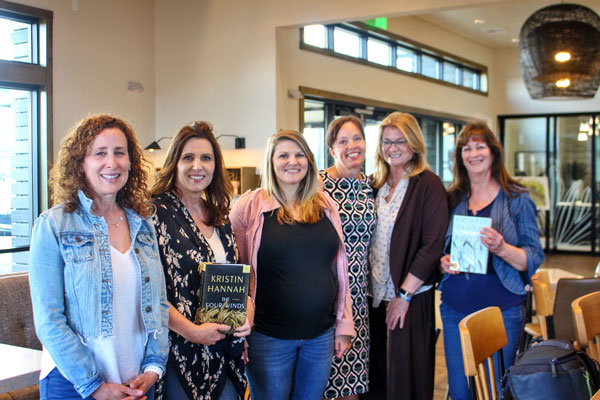The Four Winds
Article and photo by Hollen Wheeler

A new book club met at The Exchange Coffee House in May to discuss The Four Winds. Pictured left to right are Melissa Forstein, Jeanie Lieberenz, Emily Winder, Hallie Rand, Pattie McGuinness, and Lori Cunningham. Anyone interested in joining the group may contact Jeanie Lieberenz at j3an1e@aol.com. The next book club will meet July 8.
The Great Depression and the Dust Bowl went hand in glove, and these tragic years are still considered one of America’s most arduous periods. After the Wall Street Crash of 1929, financial hardship fell across the nation and then nature turned on the agricultural and prairie states. Drought and many dry years wreaked havoc on the livelihoods of farmers and ranchers. In desperation, an estimated 400,000 migrants left their homes and headed west with hopes for jobs and survival.
Kristin Hannah’s most recent novel, The Four Winds, is a heavy and depressing historical fiction about a woman trying to make it through this era as a single mother, and despite all, teaching her children to think of others and to do the right thing.
Meet Elsa. She is a 25 year old who has learned to hide in plain sight in her wealthy family’s home in the Texas Panhandle. For being sickly as a child, she became an outcast to them, shunned and ignored. Elsa hangs on the words of her beloved but deceased grandfather, “Be brave.”
In one act of rebellion, Elsa dons a fancy dress and goes to the local dance hall. She meets tall, dark and Italian Rafe Martinelli. Elsa becomes pregnant and is forced to marry first-generation Rafe, which prompts the official disownment by her parents. Farmers Rosa and Tony Martinelli adopt Elsa as their own but Rafe is not meant for the hardship of the Dust Bowl.
After their crops fail, followed by years of hunger and poverty, Elsa sets out for California with her two kids in tow, feisty Loreda (13) and Anthony (9). When they reach California, they find the only place to stay is a refugee camp with hundreds of displaced families – desperate, hungry, and living in unsanitary conditions.
Elsa remembers her grandfather’s words, but at every juncture she is thwarted. No jobs and no food. Eventually, the Martinellis land at Welty Farms, where working families stay in Welty cabins, get to “shop” at the Welty store and pick cotton at reduced rates because they are tenants. Despite having a roof over their heads and work, they ultimately find that the Welty system is abusive – the cabin rent is $6 per month and is taken out of their measly pay for back-breaking cotton picking. The store issues everything on credit so in the end, the families are indentured servants to the Welty empire.
Loreda is appalled by the injustice of the Welty operations. Along the way, she befriends Jack, a leader and activist in the Workers Alliance. He urges the Martinellis and her fellow migrant workers to join the union and strike to demand fair wages for their work. At first, Elsa is reluctant but ultimately comes to see that fighting back is the right thing to do. She, who spent her life trying to be invisible and thinking she isn’t brave, stands up for justice, finds her voice and leads a strike. In her journal, Elsa chronicles her evolution: “A warrior believes in an end she can’t see and fights for it. A warrior never gives up. A warrior fights for those weaker than herself. It sounds like motherhood to me.”
The Four Winds is a tough but important read. In her epilogue, it’s notable that Hannah acknowledges the relevance of completing her novel, set during the Great Depression, amid a global pandemic and the similarities between then and 2020: economic crisis, sickness, fear and uncertainty about the future. “History has shown us the strength and durability of the human spirit. In the end, it is our idealism and courage and our commitment to one another – what we have in common – that will save us,” she adds.
